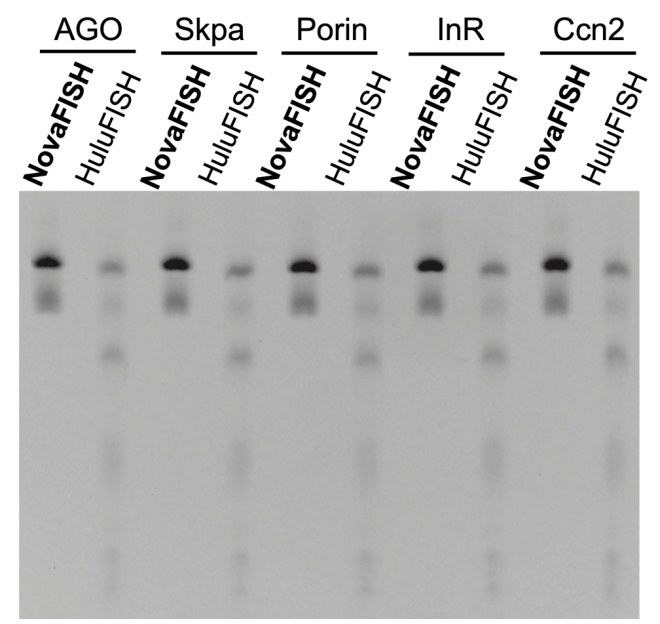
If you have been working with us for a couple of years, you probably already noticed that our single-molecule Fluorescent In Situ Hybridization Probes changed names and are not called HuluFISH Probes anymore, but NovaFISH Probes. However, not only was it the name that changed, but also did the structure.
HuluFISH probes consisted of the selected sequence(s) for recognition and binding to the target RNA and a short lag sequence that was later enzymatically ligated to other short sequences that are chemically bound to the fluorophores. Thus, HuluFISH Probes achieved efficient recognition and binding without steric hindrance from the fluorophores attached or any other form of impediment. This is true for all of the sequences that constitute the pool provided to you in one tube for thorough identification and detection of your target. Also, these short sequences can have multiple fluorophore units, making it possible for us to deliver to you probes with (comfortably) up to 9 fluorophores per sequence, thus maximizing the signal per RNA molecule.
NovaFISH Probes come with all of those technical advantages but are also more stable. Now, the last lag sequences containing the fluorophores are ligated to an adaptor in a stem loop system that makes these fluorescent sequences double-stranded, and therefore more stable, without altering in any form the recognition sequence, as it can be seen in Figure 1.

Figure 1: assembly and structure of NovaFISH Probes. The short sequences containing the fluorophores are now bound to an adaptor in a stem loop system, which results in increased stability, without producing any changes on the recognition sequence.
All the technical features you know from HuluFISH Probes are maintained in NovaFISH Probes, giving you the same quality and performance, and also the possibility of multiplexing. That did not change either, it is still possible to detect up to 7 genes in one single round of hybridization and, with a state-of-the-art microscope with 7 channels, it is possible to scale up multiplexing to up to 120 genes, as it can be seen in Figure 2.

Figure 2: NovaFISH Probes just are a structural improvement of HuluFISH Probes. NovaFISH Probes still provide the same quality and performance, as well as the capacity of simultaneous detection of up to 7 genes in one single hybridization reaction and the capacity of multiplex-detection.
Last, but not least, the improvement in the structure also reflected in the efficiency of production, with up to 300% increase in the yield observed in the previous method, and with substantially fewer side products, allowing us to significantly upscale the production, and deliver higher amounts of NovaFISH Probes than ever before (Figure 3).

Figure 3: 5 different probes were produced with the old method and the NovaFISH technology. In this image from Urea-PAGE the top bands correspond to the desired products, being all the bands below side products. It is clear that the efficiency of production is much higher in NovaFISH Probes, and the number of side products is very importantly reduced.
Our patented technology “new Modality Enzymatic Convergent Assembly” (nMECA) allows us to increase the purity and production quality of these products as well. To find out more about our unique technology, and how it allows us to provide unprecedented purity in our other products, such as sgRNAs, pegRNAs, etc., we welcome you to keep exploring our website, where you will find other blogs and more content from our R&D department. If you have specific questions, do not hesitate to contact us as info@pixelbiosciences.com. For orders, we welcome you to also create and account here in our website to have access to our user-friendly online shop, where you can place an order quickly providing the necessary product information. In case you have a specific request or you need a highly customized product, we welcome you to contact us at order@pixelbiosciences.com

